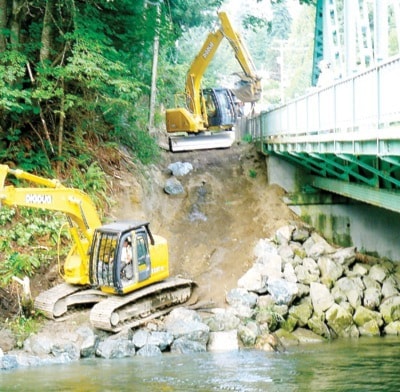The Ministry of Highways is taking action to ensure the Little Qualicum River doesn’t take out Highway 19A, but they’re doing it in an environmentally responsible way.
Biologist Sean Wong is working with the Ministry of Transportation on the project, ensuring that continual scouring by the river keeps it flowing under the bridge, while at the same time improving fish habitat on the stretch of river.
“The river bank has been eroding on the Qualicum Beach side and if it continues to erode and laterally migrate, it will eventually hit the highway instead of flowing under the bridge,” Wong said. “That would present a public safety hazard.”
Storm events in 2009 and 2010 were seen as emergency events, sparking workers to place emergency rip-rap to protect the bridge.
Wong said the ministry is now working on a more permanent solution.
“The long-term fix is to work along 200 metres of bank to stabilize it so it continues to flow under the bridge,” he said.
“While we do this we are incorporating environmental features such as large woody debris that provides habitat, cover and complexity for coho or trout that hide in root masses.”
As well, he said, workers are excavating a historic flood channel to create an off-channel pond that will provide year-round habitat for fish.
“Coho salmon spend a full year in the river, so it’s important for juveniles to have a place where they can get out of the main flows and not be swept out,” Wong said.
“The pond will have areas that are one and a half metres deep or deeper in the summer, so there will be nice cool water in it.”
Wong said he’s confident the stretch of river will have better fish habitat than it has currently, as the bank is fairly smooth and featureless as it stands.
“The bank doesn’t have much in the way of vegetation or features,” he said. “Fish like complexity. They like variations for cover.
“The juveniles have a lot of predators to avoid, such as eagles, heron, kingfishers and mink.”
“A root mass will provide areas that break up the flow and provide protection from predators far better than a uniform bank.”
Indeed, he said the addition of woody debris and root balls can increase the productivity of an area by five-fold or more.
“We can enhance it further by planting native trees such as willows and dogwoods,” he said. “We just jam a branch into the ground and it will grow into a shrub.”
Wong said he expects the project, which began last week, to take about a month to complete — although that depends in part on river flows.
“We have the second highest snowpack on record and elevated runoff flows,” he said. “However, they’re dropping slowly and we can do other activities, such as the off-channel pond, which aren’t impacted by the flows.”
Wong said he has worked in consultation with the Qualicum First Nation to identify any archeological sites along the bank and is consulting with the local Streamkeepers group to ensure everyone is kept up to speed.
Streamkeepers spokesperson Faye Smith said she’s encouraged by Wong’s participation in the project.
“Sean is including as much fish habitat as possible, given that there are a lot of hard materials going in there,” Smith said. “We have worked with Sean and the Ministry of Transportation on projects before, particularly up at Whiskey Creek, a tributary of the Little Qualicum. It’s great when Sean can get involved with projects.”
